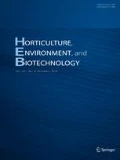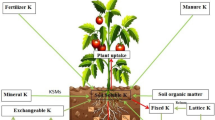Abstract
Vanda is an aerial tropical orchid native to Thailand and nitrogen (N) fertilizer is mainly used to promote its growth and quality. However, little is known about the characteristics of N absorption and assimilation in Vanda. The objective of this study was to determine the appropriate source of N for Vanda cultivation. In this experiment, shoots and roots of Vanda ‘Ratchaburi Fuchs-Katsura’ were sprayed weekly with 100 ml of 15N tracer solution (1) 10 mM of 15NO3−, (2) 5 mM of 15NO3− plus 5 mM of NH4+, (3) 5 mM of NO3− plus 5 mM of 15NH4+ and (4) 10 mM of 15NH4+. The results indicated that plants fed with a combined N fertilizer gave the highest of 15N use efficiency (15NUE) of about 21.8%, 30 days after the first feeding (DAF), compared with those fed sole sources of 15NO3− (21.0%) and 15NH4+ (16.6%). However, a sole nitrate fertilizer or combination fertilizer did not significantly affect the total N and labelled N content. Alanine was a major amino acid found in leaves and roots at 7 DAF, whereas glutamine was mainly found in stems. At 30 DAF, tyrosine and alanine became major components in the leaves, and glutamine decreased in stems when plants were fed with a single 15NH4+source.





Similar content being viewed by others
References
Arditti J (1992) Fundamentals of Orchid biology. Wiley, New York
Barneix AJ, Causin HF (1996) The central role of amino acids on nitrogen utilization and plant growth. J Plant Physiol 149:358–362
Bittsánszky A, Pilinszky K, Gyulai G, Komives T (2015) Overcoming ammonium toxicity. Plant Sci 231:184–190
D’Mello JPF (2015) Amino acids in higher plants. CAB International, Oxfordshire, pp 30–82
Fageria NK (2014) Nitrogen management in crop production. CRC Press, New York
Fu SF, Lin CW, Kao TW, Huang DD, Huang HJ (2011) PaPTP1, a gene encoding protein tyrosine phosphatase from orchid, Phalaenopsis amabilis, is regulated during floral development and induced by wounding. Plant Mol Biol Rep 29:106–116
Gaudin R, Dupuy J (1999) Ammonium nutrition of transplanted rice fertilized with large urea granules. Agron J 91:33–36
Gaudry JFM (2001) Nitrogen assimilation by plants: physiology, biochemical and molecular aspects. Science Publishers, New york
Grove DL (1995) Vandas and ascocendas and their combinations with other genera. Timber Press, Inc, Portland
Hammarström L, Sun L, Åkermark B, Styring S (2000) Mimicking photosystem II reactions in artificial photosynthesis: Ru(II)-polypyridine photosensitisers linked to tyrosine and manganese electron donors. Catal Today 58:57–69
Henry LT, Raper CD (1989) Effects of root zone acidity on utilization of nitrate and ammonium in tobacco plants. J Plant Nutr 12:811–826
Hew CS, Yong JWH (2004) The physiology of tropical orchids in relation to the industry, 2nd edn. The World Scientific Publishing, Singapore
Hew CS, Yam TW, Arditti J (2002) Biology of Vanda Miss Joaquim. Singapore University Press, Singapore
Kamemoto H, Sagarik R (1975) Beautiful Thai orchid species. Orchid Society of Thailand, Bangkok
Lekawatana S (2010) Thai orchid: current situation. In: Article of the 2010 Taiwan international orchid symposium. Tainan, Taiwan
Luan S (2002) Tyrosine phosphorylation in plant cell signaling. Proc Natl Acad Sci USA 99:11567–11569
Majerowicz N, Kerbauy GB, Nievola CC, Suzuki RM (2000) Growth and nitrogen metabolism of Catasetum fimbriatum (Orchidaceae) grown with different nitrogen sources. Environ Exp Bot 44:195–206
Marschner H (1986) Mineral nutrition of higher plants. Academic press, London, p 674
Marschner P (2012) Marschner’s mineral nutrition of higher plants. Academic Press, MA
Mengel K, Kirkby EA (1987) Principles of plant nutrition. International Potash Institute, Bern
Mengel K, Kosegarten H, Appel T, Kirkby EA (2012) Principles of plant Nutrition. In: Mengel K, Kirkby EA (eds) Nutrient uptake and assimilation, 5th edn. Springer, Netherlands, pp 130–133
Miwa TK (1954) An amino acid analysis of the flower of the vanda orchid Miss Joaquim. Master thesis, The Graduate School of the University of Hawaii
Ohyama T, Sueyoshi K (2010) Nitrogen assimilation in plants. Research Signpost, Kerala
Pilbem DJ, Kirkby EA (1992) Some aspects of the utilization of nitrate and ammonium by plants. In: Nitrogen metabolism in plants. Proceedings of phytochemical society of Europe. Oxford Science Publications, pp 55–70
Rittershausen W, Rittershausen B (2001) The gardener’s guide to growing orchids. Timber Press, Inc, Portland
Ruamrungsri S, Ruamrungsri S, Ikarachi T, Ohyama T (2000) Ammonium and nitrate assimilation in Narcissus roots. J Hortic Sci Biotechnol 75:223–227
Ruamrungsri S, Sato T, Khuankaew T, Ohyama T (2014) Nitrogen sources and its uptake in Dendrobium orchid by 15N tracer. Acta Hortic 1025:207–211
Sandrock DR, Righetti TL, Azarenko AN (2005) Isotopic and nonisotopic estimation of nitrogen uptake efficiency in container-grown woody ornamentals. Hortic Sci 40(3):665–669
Stewart J (2000) Orchids. Timber Press, Inc, Portland (Revised ed)
Susilo H, Peng YC, Lee SC, Chen YC, Chang YCA (2013) The uptake and partitioning of nitrogen in Phalaenopsis Sogo Yukidian ‘V3’ as shown by N-15 as a tracer. J Am Soc Hortic Sci 138:229–237
Tischner R (2001) Nitrate uptake and reduction in higher and lower plants. Plant Cell Environ 23:1005–1024
Tsavkelova EA, Lobakova ES, Kolomeitseva GL, Cherdyntseva TA, Netrusov AI (2003) Associative cyanobacteria isolated from the roots of epiphytic orchids. Microbiol Res 72:92–97
Acknowledgements
This work was supported by the Graduate School of Science and Technology at Niigata University and the Aksel T Schau Charitable Foundation. We acknowledge the Department of Environmental Science, the Faculty of Bioresource Sciences at Akita Prefectural University, and H.M. the King’s Initiative Centre for Flower and Fruit Propagation, Thailand for isotope analysis and facilities.
Author information
Authors and Affiliations
Corresponding author
Rights and permissions
About this article
Cite this article
Panjama, K., Ohyama, T., Ohtake, N. et al. Identifying N sources that affect N uptake and assimilation in Vanda hybrid using 15N tracers. Hortic. Environ. Biotechnol. 59, 805–813 (2018). https://doi.org/10.1007/s13580-018-0071-6
Received:
Revised:
Accepted:
Published:
Issue Date:
DOI: https://doi.org/10.1007/s13580-018-0071-6




